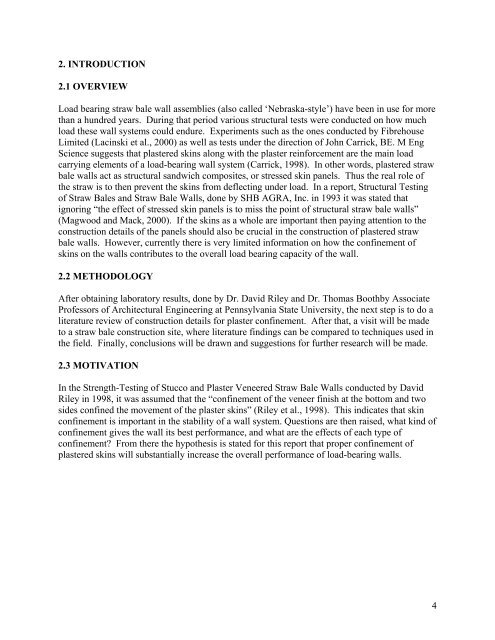the effects of plaster skin confinement on the performance of straw ...
the effects of plaster skin confinement on the performance of straw ...
the effects of plaster skin confinement on the performance of straw ...
You also want an ePaper? Increase the reach of your titles
YUMPU automatically turns print PDFs into web optimized ePapers that Google loves.
2. INTRODUCTION<br />
2.1 OVERVIEW<br />
Load bearing <strong>straw</strong> bale wall assemblies (also called ‘Nebraska-style’) have been in use for more<br />
than a hundred years. During that period various structural tests were c<strong>on</strong>ducted <strong>on</strong> how much<br />
load <str<strong>on</strong>g>the</str<strong>on</strong>g>se wall systems could endure. Experiments such as <str<strong>on</strong>g>the</str<strong>on</strong>g> <strong>on</strong>es c<strong>on</strong>ducted by Fibrehouse<br />
Limited (Lacinski et al., 2000) as well as tests under <str<strong>on</strong>g>the</str<strong>on</strong>g> directi<strong>on</strong> <str<strong>on</strong>g>of</str<strong>on</strong>g> John Carrick, BE. M Eng<br />
Science suggests that <str<strong>on</strong>g>plaster</str<strong>on</strong>g>ed <str<strong>on</strong>g>skin</str<strong>on</strong>g>s al<strong>on</strong>g with <str<strong>on</strong>g>the</str<strong>on</strong>g> <str<strong>on</strong>g>plaster</str<strong>on</strong>g> reinforcement are <str<strong>on</strong>g>the</str<strong>on</strong>g> main load<br />
carrying elements <str<strong>on</strong>g>of</str<strong>on</strong>g> a load-bearing wall system (Carrick, 1998). In o<str<strong>on</strong>g>the</str<strong>on</strong>g>r words, <str<strong>on</strong>g>plaster</str<strong>on</strong>g>ed <strong>straw</strong><br />
bale walls act as structural sandwich composites, or stressed <str<strong>on</strong>g>skin</str<strong>on</strong>g> panels. Thus <str<strong>on</strong>g>the</str<strong>on</strong>g> real role <str<strong>on</strong>g>of</str<strong>on</strong>g><br />
<str<strong>on</strong>g>the</str<strong>on</strong>g> <strong>straw</strong> is to <str<strong>on</strong>g>the</str<strong>on</strong>g>n prevent <str<strong>on</strong>g>the</str<strong>on</strong>g> <str<strong>on</strong>g>skin</str<strong>on</strong>g>s from deflecting under load. In a report, Structural Testing<br />
<str<strong>on</strong>g>of</str<strong>on</strong>g> Straw Bales and Straw Bale Walls, d<strong>on</strong>e by SHB AGRA, Inc. in 1993 it was stated that<br />
ignoring “<str<strong>on</strong>g>the</str<strong>on</strong>g> effect <str<strong>on</strong>g>of</str<strong>on</strong>g> stressed <str<strong>on</strong>g>skin</str<strong>on</strong>g> panels is to miss <str<strong>on</strong>g>the</str<strong>on</strong>g> point <str<strong>on</strong>g>of</str<strong>on</strong>g> structural <strong>straw</strong> bale walls”<br />
(Magwood and Mack, 2000). If <str<strong>on</strong>g>the</str<strong>on</strong>g> <str<strong>on</strong>g>skin</str<strong>on</strong>g>s as a whole are important <str<strong>on</strong>g>the</str<strong>on</strong>g>n paying attenti<strong>on</strong> to <str<strong>on</strong>g>the</str<strong>on</strong>g><br />
c<strong>on</strong>structi<strong>on</strong> details <str<strong>on</strong>g>of</str<strong>on</strong>g> <str<strong>on</strong>g>the</str<strong>on</strong>g> panels should also be crucial in <str<strong>on</strong>g>the</str<strong>on</strong>g> c<strong>on</strong>structi<strong>on</strong> <str<strong>on</strong>g>of</str<strong>on</strong>g> <str<strong>on</strong>g>plaster</str<strong>on</strong>g>ed <strong>straw</strong><br />
bale walls. However, currently <str<strong>on</strong>g>the</str<strong>on</strong>g>re is very limited informati<strong>on</strong> <strong>on</strong> how <str<strong>on</strong>g>the</str<strong>on</strong>g> <str<strong>on</strong>g>c<strong>on</strong>finement</str<strong>on</strong>g> <str<strong>on</strong>g>of</str<strong>on</strong>g><br />
<str<strong>on</strong>g>skin</str<strong>on</strong>g>s <strong>on</strong> <str<strong>on</strong>g>the</str<strong>on</strong>g> walls c<strong>on</strong>tributes to <str<strong>on</strong>g>the</str<strong>on</strong>g> overall load bearing capacity <str<strong>on</strong>g>of</str<strong>on</strong>g> <str<strong>on</strong>g>the</str<strong>on</strong>g> wall.<br />
2.2 METHODOLOGY<br />
After obtaining laboratory results, d<strong>on</strong>e by Dr. David Riley and Dr. Thomas Boothby Associate<br />
Pr<str<strong>on</strong>g>of</str<strong>on</strong>g>essors <str<strong>on</strong>g>of</str<strong>on</strong>g> Architectural Engineering at Pennsylvania State University, <str<strong>on</strong>g>the</str<strong>on</strong>g> next step is to do a<br />
literature review <str<strong>on</strong>g>of</str<strong>on</strong>g> c<strong>on</strong>structi<strong>on</strong> details for <str<strong>on</strong>g>plaster</str<strong>on</strong>g> <str<strong>on</strong>g>c<strong>on</strong>finement</str<strong>on</strong>g>. After that, a visit will be made<br />
to a <strong>straw</strong> bale c<strong>on</strong>structi<strong>on</strong> site, where literature findings can be compared to techniques used in<br />
<str<strong>on</strong>g>the</str<strong>on</strong>g> field. Finally, c<strong>on</strong>clusi<strong>on</strong>s will be drawn and suggesti<strong>on</strong>s for fur<str<strong>on</strong>g>the</str<strong>on</strong>g>r research will be made.<br />
2.3 MOTIVATION<br />
In <str<strong>on</strong>g>the</str<strong>on</strong>g> Strength-Testing <str<strong>on</strong>g>of</str<strong>on</strong>g> Stucco and Plaster Veneered Straw Bale Walls c<strong>on</strong>ducted by David<br />
Riley in 1998, it was assumed that <str<strong>on</strong>g>the</str<strong>on</strong>g> “<str<strong>on</strong>g>c<strong>on</strong>finement</str<strong>on</strong>g> <str<strong>on</strong>g>of</str<strong>on</strong>g> <str<strong>on</strong>g>the</str<strong>on</strong>g> veneer finish at <str<strong>on</strong>g>the</str<strong>on</strong>g> bottom and two<br />
sides c<strong>on</strong>fined <str<strong>on</strong>g>the</str<strong>on</strong>g> movement <str<strong>on</strong>g>of</str<strong>on</strong>g> <str<strong>on</strong>g>the</str<strong>on</strong>g> <str<strong>on</strong>g>plaster</str<strong>on</strong>g> <str<strong>on</strong>g>skin</str<strong>on</strong>g>s” (Riley et al., 1998). This indicates that <str<strong>on</strong>g>skin</str<strong>on</strong>g><br />
<str<strong>on</strong>g>c<strong>on</strong>finement</str<strong>on</strong>g> is important in <str<strong>on</strong>g>the</str<strong>on</strong>g> stability <str<strong>on</strong>g>of</str<strong>on</strong>g> a wall system. Questi<strong>on</strong>s are <str<strong>on</strong>g>the</str<strong>on</strong>g>n raised, what kind <str<strong>on</strong>g>of</str<strong>on</strong>g><br />
<str<strong>on</strong>g>c<strong>on</strong>finement</str<strong>on</strong>g> gives <str<strong>on</strong>g>the</str<strong>on</strong>g> wall its best <strong>performance</strong>, and what are <str<strong>on</strong>g>the</str<strong>on</strong>g> <str<strong>on</strong>g>effects</str<strong>on</strong>g> <str<strong>on</strong>g>of</str<strong>on</strong>g> each type <str<strong>on</strong>g>of</str<strong>on</strong>g><br />
<str<strong>on</strong>g>c<strong>on</strong>finement</str<strong>on</strong>g>? From <str<strong>on</strong>g>the</str<strong>on</strong>g>re <str<strong>on</strong>g>the</str<strong>on</strong>g> hypo<str<strong>on</strong>g>the</str<strong>on</strong>g>sis is stated for this report that proper <str<strong>on</strong>g>c<strong>on</strong>finement</str<strong>on</strong>g> <str<strong>on</strong>g>of</str<strong>on</strong>g><br />
<str<strong>on</strong>g>plaster</str<strong>on</strong>g>ed <str<strong>on</strong>g>skin</str<strong>on</strong>g>s will substantially increase <str<strong>on</strong>g>the</str<strong>on</strong>g> overall <strong>performance</strong> <str<strong>on</strong>g>of</str<strong>on</strong>g> load-bearing walls.<br />
4
















